Top 10 Best Ecommerce Website Design Ideas for 2025
Elevate Your Online Store with Stunning Designs
Want to create the best ecommerce website design for your business? A poorly designed website loses customers. This list of top 10 ecommerce platforms for 2025 helps you choose the right tool to build a high-converting online store. Discover options like Shopify, WooCommerce, BigCommerce, and more, each with unique features for diverse business needs. This guide helps you find the best fit for your online retail success.
1. Shopify
Shopify stands out as a leading contender for businesses seeking the best ecommerce website design. This cloud-based platform offers a comprehensive suite of tools that simplify creating, customizing, and managing online stores. Its user-friendly interface makes it accessible even for beginners, while its robust features cater to the growing demands of established businesses. Shopify's popularity is a testament to its effectiveness, powering over 1.75 million businesses globally. Its comprehensive ecosystem offers everything from payment processing and inventory management to potent marketing features, making it a one-stop solution for many online retailers. This combined with the availability of over 8,000 apps and 100+ professional themes makes Shopify a truly versatile platform for building a successful online presence.

One of Shopify's most significant advantages is its intuitive drag-and-drop store builder. This feature allows users to easily create and customize their online store's layout without needing extensive coding knowledge. Choosing from a range of mobile-responsive themes ensures a seamless shopping experience across various devices, crucial in today's mobile-first world. Built-in payment processing simplifies transactions, while multi-channel selling capabilities allow businesses to expand their reach across social media platforms and online marketplaces. Further enhancing its appeal, Shopify provides advanced analytics and reporting tools to track key performance indicators and make data-driven decisions. For those in the EE region looking to expand their online presence, this data becomes invaluable for understanding market trends and customer behavior specific to their location.
For businesses looking to delve deeper into their ecommerce strategy, Learn more about Shopify.
Shopify's pricing structure operates on a monthly subscription basis, with plans starting at $29. While this provides access to the core features, businesses should be aware of transaction fees applied to each sale unless they utilize Shopify Payments. As businesses grow and require more advanced functionalities, opting for premium apps and themes can lead to increased costs. This scalability, while beneficial, necessitates careful planning and budgeting, particularly for startups and small businesses. While the platform boasts a user-friendly interface, achieving highly customized designs often requires some coding knowledge or the assistance of a Shopify expert.
Compared to other ecommerce platforms like WooCommerce or BigCommerce, Shopify shines in its ease of use and comprehensive feature set. WooCommerce, while offering flexibility and extensive customization options, often requires more technical expertise. BigCommerce, similar to Shopify in its all-in-one approach, may present a steeper learning curve for beginners. For businesses in the EE region looking for a platform that balances ease of use with powerful features, Shopify presents a compelling option.
Implementing Shopify is relatively straightforward. After choosing a suitable subscription plan and selecting a theme, businesses can customize their online store's appearance, upload products, configure payment gateways, and set up shipping options. The platform’s extensive documentation and 24/7 customer support provide valuable assistance throughout the setup process. Consider these implementation tips: plan your store's layout and navigation carefully for optimal user experience, optimize product descriptions and images for search engines, and leverage Shopify's marketing tools to drive traffic and sales.
For small and medium-sized enterprises in the EE region aiming for professional corporate websites, Shopify offers a robust and scalable solution. Online retailers seeking scalable e-commerce solutions will appreciate the platform's comprehensive features and ease of management. Startups and tech firms needing custom mobile applications can leverage Shopify's app ecosystem to enhance their online presence. Brands and organizations aiming to enhance UI/UX design will find the platform’s themes and customization options appealing. Even entrepreneurs and freelancers requiring simple business-card sites or landing pages can benefit from Shopify’s user-friendly interface and streamlined setup process. Ultimately, Shopify’s blend of user-friendliness, robust features, and extensive support make it a worthy contender for the title of best ecommerce website design platform.
2. WooCommerce
WooCommerce stands as a dominant force in the world of ecommerce, providing a robust and flexible platform for businesses of all sizes. It's a free, open-source plugin specifically designed for WordPress, effectively transforming any WordPress website into a fully functional online store. This makes it an exceptionally attractive option for businesses already leveraging WordPress for their online presence, as well as those familiar with the platform's user-friendly interface. Its popularity is undeniable, powering over 28% of all online stores globally, demonstrating its capability and widespread adoption. This substantial market share speaks volumes about its effectiveness and reliability as an ecommerce solution, particularly for businesses seeking the best ecommerce website design. For businesses in the EE region looking to establish or enhance their online selling capabilities, WooCommerce presents a compelling solution, especially given its cost-effectiveness and extensibility.

One of WooCommerce's key strengths lies in its seamless integration with the WordPress ecosystem. This tight-knit relationship allows businesses to leverage the vast library of WordPress themes and plugins, providing unparalleled customization options. Need a specific design aesthetic? There's likely a theme for it. Require a particular functionality, like advanced shipping calculations or integration with a CRM? A plugin probably exists. This extensibility makes WooCommerce incredibly adaptable to diverse business needs, from simple online stores selling a handful of products to complex marketplaces with thousands of items and vendors.
For small and medium-sized enterprises (SMEs) in the EE region, this flexibility translates to a cost-effective solution. The core WooCommerce plugin is free, meaning you avoid hefty licensing fees common with other ecommerce platforms. While you'll need to invest in WordPress hosting and potentially some premium plugins for added functionality, the overall cost often remains significantly lower compared to proprietary platforms. Startups and tech firms can particularly benefit from this open-source nature, allowing for deep customization and integration with existing systems. Even freelancers and entrepreneurs building business-card sites or landing pages can utilize WooCommerce to incorporate online sales functionality with minimal investment.
WooCommerce offers a comprehensive set of features out-of-the-box. You can manage unlimited products and categories, configure flexible payment options (including popular gateways like PayPal and Stripe), and optimize your store for search engines thanks to its SEO-friendly structure. For online retailers looking for scalable ecommerce solutions, this is a crucial aspect. As your business grows, WooCommerce can scale alongside it, accommodating increasing product catalogs, customer traffic, and order volumes.
However, it's essential to acknowledge the potential drawbacks. While free to use, WooCommerce requires WordPress hosting and ongoing maintenance, which can be a hurdle for non-technical users. Managing updates, backups, and security can require technical expertise or the assistance of a developer. While extensive documentation and a large community are available for support, businesses without in-house technical resources might find the learning curve steep. Additionally, achieving optimal performance often depends on the quality of your hosting, necessitating careful selection.
Implementing WooCommerce involves installing the plugin on your WordPress site. Choose a reliable hosting provider with experience in supporting WooCommerce. Select a theme that aligns with your brand and customize it to your liking. Configure essential settings like payment gateways, shipping options, and tax calculations. Finally, populate your store with products and optimize product pages for search engines.
Compared to other platforms like Shopify, WooCommerce offers greater control and flexibility but requires more technical involvement. Shopify provides a more managed experience, handling hosting and maintenance for you, but at a higher recurring cost and with potentially less customization. Choosing between the two depends on your technical capabilities, budget, and desired level of control.
For businesses in the EE region focused on best ecommerce website design, WooCommerce offers a compelling proposition. Its free, open-source nature, coupled with its extensive customization options and seamless WordPress integration, makes it a powerful tool for creating engaging and effective online stores. While technical expertise may be required for optimal setup and maintenance, the potential benefits in terms of cost-effectiveness, flexibility, and control make WooCommerce a strong contender for businesses looking to establish a robust online presence.
3. BigCommerce
BigCommerce stands out as a robust and scalable SaaS ecommerce platform, specifically designed to cater to the needs of growing businesses, making it a strong contender for businesses in the EE region looking for the best ecommerce website design. It offers a comprehensive suite of enterprise-grade features without imposing transaction fees, a significant advantage for businesses focused on maximizing profit margins. Moreover, its built-in tools for SEO, marketing, and analytics provide a streamlined approach to online store management, crucial for businesses aiming to establish a strong online presence and drive sales. This makes it a particularly appealing option for ambitious SMEs, online retailers, and even startups in the EE region looking to scale rapidly.
One of the most compelling reasons for choosing BigCommerce lies in its ability to handle high-volume sales with advanced B2B functionalities. This is particularly relevant for businesses in the EE region experiencing rapid growth or those planning to expand internationally. While other platforms might require extensive customization or third-party integrations to achieve similar capabilities, BigCommerce offers these features out-of-the-box. This translates into significant time and cost savings, allowing businesses to focus on core operations rather than grappling with complex technical implementations.
BigCommerce shines with its feature-rich offering, encompassing everything from essential SEO and marketing tools to multi-channel selling capabilities. These built-in features significantly reduce the need for additional apps and integrations, streamlining operations and simplifying website management. For instance, its SEO tools help optimize product listings and content for search engines, enhancing visibility and driving organic traffic. The integrated marketing features facilitate targeted campaigns and promotions, enabling businesses to reach a wider audience and boost sales. Moreover, its multi-channel selling capabilities allow businesses to seamlessly integrate their online store with various marketplaces and social media platforms, expanding their reach and maximizing sales potential.
For businesses in the EE region engaged in B2B sales, BigCommerce's advanced B2B features offer a significant advantage. These include functionalities like quote management, customer segmentation, and wholesale pricing, all essential for managing complex B2B transactions efficiently. This focus on B2B functionalities sets BigCommerce apart from many other ecommerce platforms, making it an ideal solution for businesses operating in this space.
BigCommerce offers several pricing tiers starting at $29/month for the Standard plan, then $79/month for Plus, and $299/month for Pro. Enterprise plans are also available with custom pricing. While the starting price is higher compared to some competitors like Shopify or Wix, the absence of transaction fees across all plans, even on the entry-level Standard plan, can offset this cost, particularly for businesses processing a high volume of transactions. The higher pricing is justified by the robust feature set, scalability, and advanced capabilities that BigCommerce offers, making it a valuable investment for businesses seeking long-term growth. Consider the specific needs and budget of your business in the EE region when evaluating the pricing structure.
From a technical standpoint, BigCommerce boasts unlimited bandwidth and file storage, ensuring optimal website performance and loading speeds, crucial for providing a seamless user experience. Its excellent API allows for custom integrations, enabling businesses to tailor the platform to their specific requirements. However, while the platform offers powerful customization options, theme customization might require some technical knowledge. Furthermore, while BigCommerce has a selection of themes, the number of free themes is limited compared to competitors, which might be a consideration for budget-conscious businesses.
Setting up a BigCommerce store involves selecting a theme, customizing its design, adding products, configuring payment gateways, and setting up shipping options. While the platform is generally user-friendly, some aspects, particularly theme customization, might require technical expertise. For businesses in the EE region lacking in-house technical skills, engaging a BigCommerce expert or agency can streamline the setup process and ensure optimal website design.
In comparison to platforms like Shopify, BigCommerce excels in its robust B2B features and lack of transaction fees. While Shopify offers a wider selection of free themes and a slightly easier learning curve for beginners, BigCommerce's focus on scalability and enterprise-grade features makes it a compelling choice for businesses aiming for significant growth within the EE region's competitive ecommerce landscape. [Link to Website: https://www.bigcommerce.com]
4. Squarespace
Squarespace has carved a niche for itself as a premier website builder, particularly for businesses prioritizing aesthetics and seamless user experience. Its strength lies in providing beautifully designed templates that require minimal technical expertise to implement, making it an attractive option for those seeking a quick and stylish entry into the online world. For businesses in the EE region looking to establish a strong online presence with a focus on visual appeal, Squarespace offers a compelling solution for crafting a professional and engaging website. This platform particularly excels for creative businesses, lifestyle brands, artists, photographers, and design-conscious entrepreneurs seeking a cohesive online presence. Its drag-and-drop interface and all-in-one platform make it incredibly user-friendly, even for beginners.
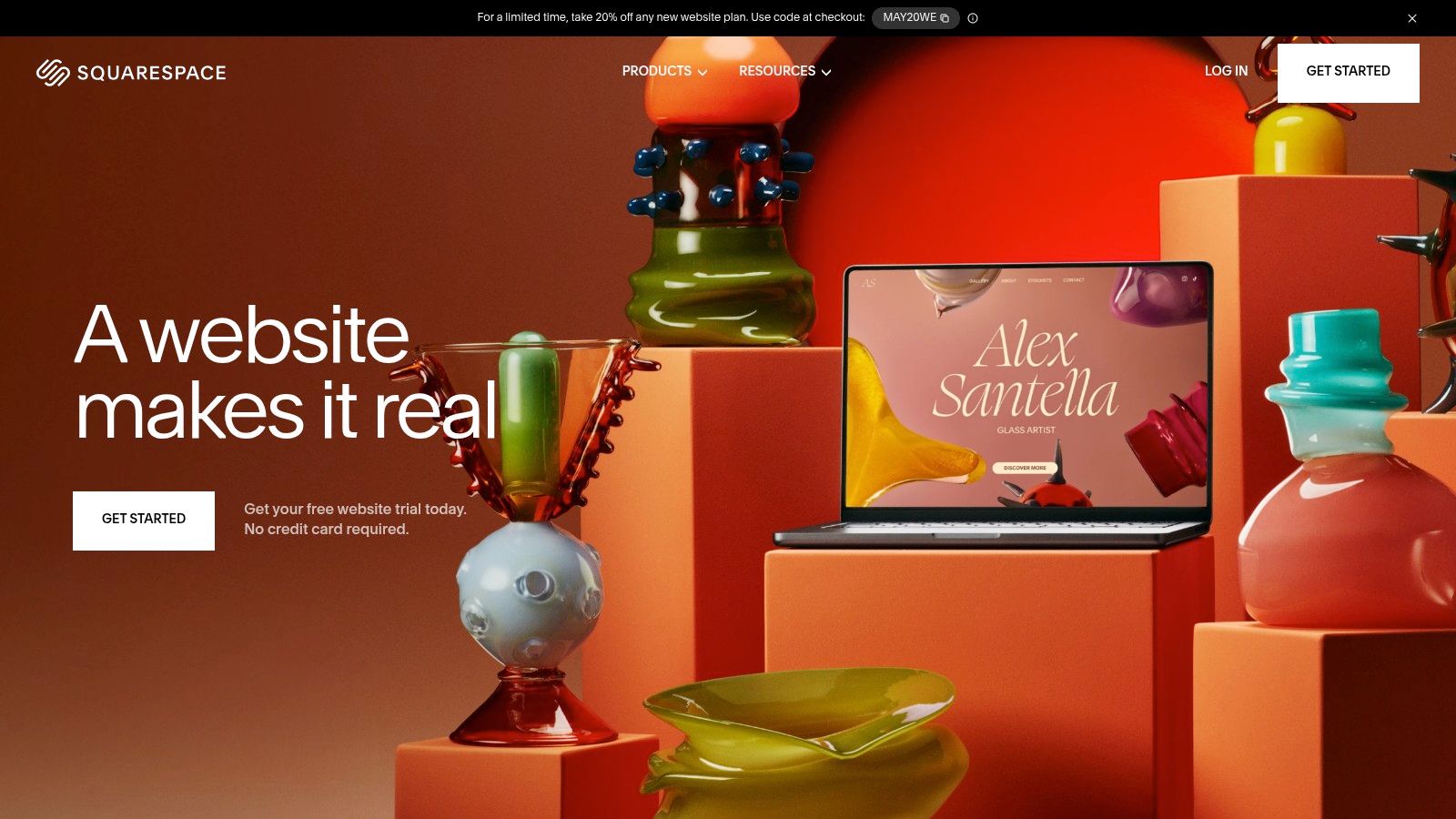
Squarespace stands out among other website builders with its award-winning designer templates. These templates provide a polished and professional foundation, allowing users to easily customize their website’s appearance without requiring extensive coding knowledge. This is a significant advantage for small and medium-sized enterprises (SMEs) in the EE region who may not have dedicated web development resources. It also allows startups and freelancers to quickly establish a professional online presence with minimal upfront investment. Furthermore, Squarespace simplifies website management with its all-in-one platform, including hosting, domain registration, and security features, allowing businesses to focus on their core operations rather than technical website maintenance.
One of Squarespace's key strengths lies in its integrated blogging platform, making it ideal for content marketing strategies. This feature is crucial for businesses looking to improve their search engine optimization (SEO) and attract organic traffic. The built-in SEO tools further enhance this capability, providing users with the tools they need to optimize their website for search engines and reach a wider audience. This focus on content creation and SEO aligns perfectly with the needs of online retailers looking to drive traffic and conversions through engaging content. While platforms like Shopify might offer more robust ecommerce features, Squarespace provides a balanced approach, offering a strong content marketing foundation alongside its online store capabilities. This makes it a particularly suitable option for businesses looking to establish a strong brand presence through content creation and storytelling. Learn more about Squarespace to understand how UI/UX design can elevate your online presence and enhance user engagement.
Squarespace’s mobile-optimized designs are essential in today's mobile-first world. With a growing number of users accessing websites from their mobile devices, having a responsive website is crucial for reaching a wider audience. This is particularly relevant in the EE region, where mobile penetration rates are high. Squarespace also offers seamless social media integration, allowing businesses to connect their website to their social media profiles and promote their products and services across multiple platforms.
While Squarespace excels in design and ease of use, it's important to be aware of its limitations. Its ecommerce features, while functional, are less extensive than those offered by dedicated ecommerce platforms like Shopify. This makes Squarespace better suited for businesses with smaller product catalogs and simpler ecommerce needs. Furthermore, while customization is possible, Squarespace offers less flexibility than platforms like WordPress, which allows for extensive code-level modifications. The smaller app marketplace also means fewer integrations are available compared to other platforms.
Pricing for Squarespace varies depending on the chosen plan, starting from around $16 per month for the Personal plan and going up to $49 per month for the Advanced Commerce plan. Each plan offers different features and capabilities, allowing businesses to choose the one that best suits their needs. The technical requirements are minimal, as Squarespace is a cloud-based platform accessible through any web browser.
In conclusion, Squarespace deserves its place on this list of best ecommerce website design tools because it offers a unique blend of stunning design, user-friendliness, and essential ecommerce functionality. It's an excellent choice for businesses in the EE region prioritizing aesthetics, content marketing, and a streamlined online presence, especially those with smaller product catalogs and a focus on visual storytelling. However, businesses with extensive ecommerce needs or requiring highly customized solutions might need to consider alternative platforms.
5. Wix eCommerce
Wix eCommerce presents a compelling option for businesses in the EE region seeking to establish a robust online presence. This platform seamlessly blends an intuitive drag-and-drop website builder with comprehensive e-commerce tools, making it a strong contender for the best ecommerce website design. This all-in-one solution caters particularly well to small and medium-sized businesses looking for a balance between ease of use and functionality, without requiring extensive technical expertise. It empowers users to build professional online stores without needing to delve into complex coding. Whether you're a startup in Tallinn, a retailer in Riga, or a freelancer in Vilnius, Wix offers a streamlined path to launching your online venture.

One of Wix's most significant advantages is its user-friendly drag-and-drop interface. Even users with limited technical skills can quickly grasp the platform’s mechanics and begin building their online store. This intuitive design significantly reduces the learning curve associated with website development and allows businesses to focus on their products and marketing strategies rather than technical complexities. The availability of Artificial Design Intelligence (ADI) further simplifies the process. ADI can automatically create a website framework based on your answers to a few simple questions, giving you a solid foundation to customize and refine.
Wix eCommerce provides over 500 customizable templates catering to various industries and aesthetics. This diverse selection provides a starting point for building a visually appealing and professional online store that aligns with your brand identity. The Wix App Market, featuring over 250 apps, extends the platform's functionality further. These apps cater to a wide range of needs, from marketing automation and social media integration to advanced analytics and customer support tools. This extensive app ecosystem allows you to tailor your Wix store to meet your specific business requirements. The platform also includes built-in marketing and SEO tools, empowering you to optimize your online store for search engines and reach a wider audience within the EE region and beyond. Furthermore, the mobile editor ensures your online store looks and functions seamlessly across all devices, enhancing the user experience for your customers.
While Wix boasts considerable strengths, it's essential to consider its limitations. One significant drawback is the inability to switch templates after publishing. This means that choosing a template is a crucial decision that requires careful consideration. While customization options are plentiful, completely overhauling the site's structure requires starting from scratch. Another consideration is the Wix branding that appears on the free plan. While the free plan offers a valuable entry point for experimenting with the platform, upgrading to a paid plan is necessary to remove the branding and unlock more advanced e-commerce features. The lower-tier paid plans, while affordable, offer limited e-commerce functionality. Businesses with ambitious growth plans may need to consider higher-tier plans to access features like subscriptions, abandoned cart recovery, and multi-currency support. Finally, websites with many design elements or complex animations can experience slower loading times, potentially impacting user experience.
Pricing for Wix eCommerce ranges from free for a basic website to around €35 per month for the most advanced e-commerce plan. Specific features and storage capacity vary across plans. There are no specific technical requirements for using Wix, as the platform is entirely cloud-based. All you need is an internet connection and a web browser.
Compared to similar platforms like Shopify and Squarespace, Wix offers a greater degree of design flexibility with its drag-and-drop interface. Shopify, while renowned for its robust e-commerce features, can be less intuitive for beginners. Squarespace, known for its sleek templates, offers less customization freedom than Wix.
When implementing your Wix eCommerce store, start by clearly defining your target audience and business goals. This will guide your template selection and inform the features you prioritize. Leverage the Wix App Market to extend your store's functionality, and dedicate time to optimizing your site for search engines using Wix’s built-in SEO tools. Carefully consider your budget and choose a pricing plan that aligns with your business needs. Finally, thoroughly test your website across different devices to ensure a seamless user experience for all your customers in the EE region. By leveraging Wix eCommerce effectively, businesses can establish a professional and engaging online presence to drive growth and success.
6. Magento Commerce
When it comes to building a robust and scalable ecommerce website, Magento Commerce (now part of Adobe Commerce) stands as a leading contender for enterprise-level businesses. This powerful platform is designed specifically for companies with complex needs, offering a wealth of features that go far beyond basic online stores. Magento Commerce empowers businesses to create truly bespoke online experiences, catering to both B2B and B2C audiences. Its place in this list is cemented by its flexibility, scalability, and extensive customization options, making it a top choice for businesses aiming to establish a powerful online presence.
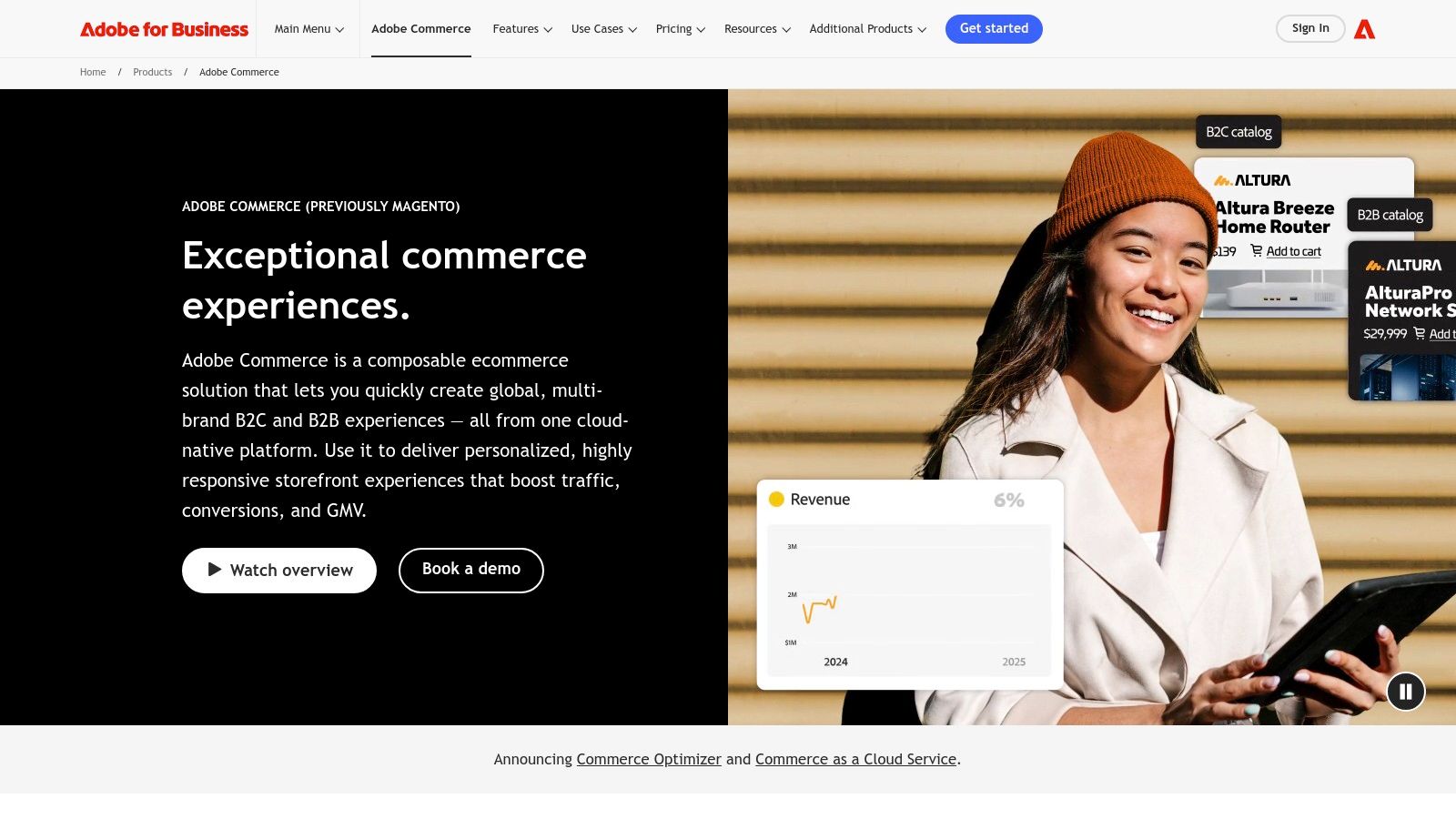
One of Magento Commerce's key strengths lies in its ability to handle large product catalogs and high traffic volumes. This makes it ideal for businesses experiencing rapid growth or those anticipating significant surges in online activity. Features like advanced inventory management, multi-store capabilities, and powerful SEO tools contribute to a seamless and optimized ecommerce experience. For online retailers in the EE region looking for a scalable solution capable of handling complex business requirements, Magento Commerce is a compelling option.
For businesses engaged in both B2B and B2C operations, Magento Commerce shines. Its advanced B2B features facilitate tailored pricing structures, custom catalogs, and complex order workflows. This allows businesses to cater to the specific needs of wholesale clients, distributors, and other business partners, all within the same platform used for direct-to-consumer sales. The multi-store functionality is particularly useful for businesses operating across different brands, regions, or even countries, enabling centralized management of multiple online storefronts.
While the platform's flexibility and power are undeniable advantages, it's crucial to acknowledge the technical expertise required for implementation and ongoing management. Magento Commerce is not a plug-and-play solution. It demands a dedicated team or experienced developers to leverage its full potential. If you're considering Magento Commerce, learn more about Magento Commerce to find the right development expertise. This is particularly relevant for businesses in the EE region, where finding skilled Magento developers can be crucial for successful implementation.
Implementing Magento Commerce requires careful planning and consideration. Start by defining your specific business requirements and mapping them to the platform's features. Consider factors like product catalog size, expected traffic volume, and the complexity of your sales processes. A thorough needs assessment will help determine if Magento Commerce is the right fit for your business. This is especially important for startups and SMEs in the EE region, where resource allocation and strategic planning are paramount.
Compared to other platforms like Shopify or WooCommerce, Magento Commerce offers unparalleled scalability and customization, but at a higher cost and complexity. While Shopify excels in ease of use and quick setup, it may lack the flexibility required for complex business models. WooCommerce, while a versatile option for smaller businesses, can struggle to handle the demands of enterprise-level operations. Magento Commerce fills this gap, offering a robust and scalable platform for businesses with significant growth ambitions.
While Adobe doesn’t publicly disclose pricing for Magento Commerce, it generally operates on a quote-based system, with costs depending on factors like business size, complexity, and required features. Expect significantly higher costs compared to SaaS platforms like Shopify, including licensing fees, implementation costs, hosting, and ongoing maintenance. Businesses should budget accordingly and factor in the long-term costs of ownership.
In conclusion, Magento Commerce is a powerful ecommerce platform ideally suited for large businesses and enterprises in the EE region seeking a highly scalable and customizable solution. While it requires technical expertise and a higher investment, the platform's robust features, advanced B2B capabilities, and extensive customization options make it a top choice for businesses looking to establish a leading online presence. Thorough planning, strategic resource allocation, and partnering with experienced developers are crucial for successful Magento Commerce implementation.
7. PrestaShop
PrestaShop is a compelling option for businesses in the EE region looking to build a robust and scalable online store. This free, open-source ecommerce platform offers a compelling balance of features and flexibility, making it a strong contender among the best ecommerce website design tools available. Its popularity in Europe and growing global presence speak volumes about its capabilities. PrestaShop is particularly well-suited for international businesses due to its inherent support for multiple languages and currencies, a feature crucial for navigating the diverse EE market. Whether you're a small startup or a growing enterprise, PrestaShop provides the tools to craft a professional online presence and effectively manage your ecommerce operations. Its comprehensive suite of features, coupled with its open-source nature, allows for a high degree of customization and control, empowering you to tailor your online store to your specific needs and target audience.
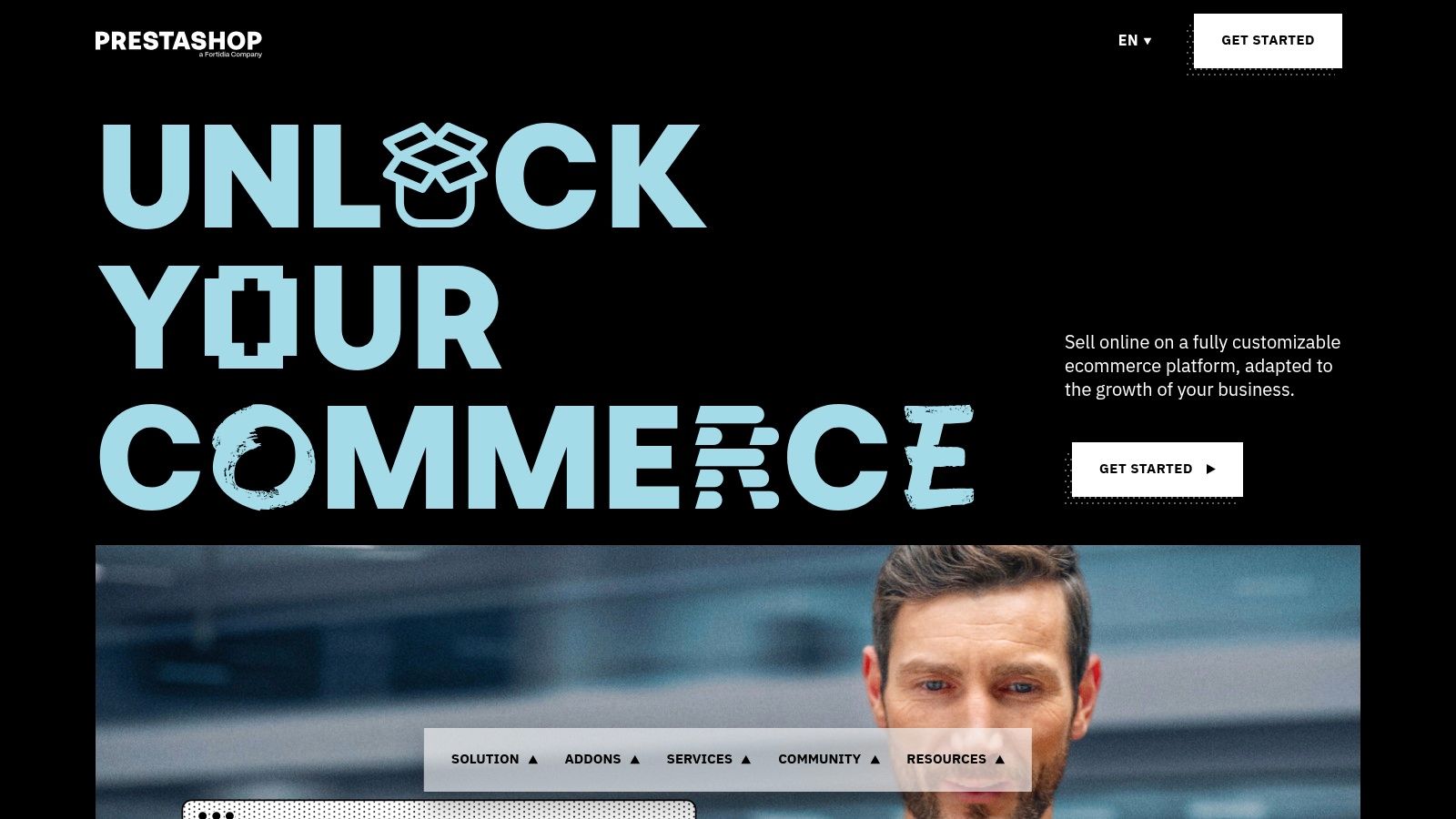
One of PrestaShop's most significant advantages is its robust feature set right out of the box. This includes advanced product catalog management, allowing you to organize and display your products effectively. Built-in marketing and SEO tools provide the necessary leverage to improve your online visibility and attract customers. A flexible theme system enables you to customize the look and feel of your store, creating a unique brand identity. Furthermore, comprehensive analytics and reporting features give you valuable insights into your store's performance, enabling data-driven decision-making. These features collectively contribute to a streamlined and efficient ecommerce experience, helping you manage your online business effectively. For a deeper dive into PrestaShop's capabilities in action, you might find this case study insightful: Learn more about PrestaShop.
For businesses in the EE region targeting diverse linguistic and cultural demographics, PrestaShop's multi-language and multi-currency support is a game-changer. This feature simplifies the process of creating localized versions of your store, catering to specific regional preferences. This is especially beneficial for reaching a wider audience and expanding your market reach across the diverse landscape of the EE region. This inherent multilingual capability sets PrestaShop apart from some competitors and positions it as an ideal solution for businesses with international aspirations.
While PrestaShop offers numerous benefits, it's also important to consider its potential drawbacks. Setting up and configuring PrestaShop can require some technical expertise, especially for more complex customizations. The platform can also be resource-intensive, potentially requiring a more powerful hosting environment compared to simpler solutions. While the core platform is free, some advanced features and extensions are available as paid modules. Lastly, while popular in Europe, PrestaShop has a smaller market share in North America, which might impact the availability of certain resources and support options.
PrestaShop excels in providing a robust and feature-rich platform for building your best ecommerce website design. Its open-source nature offers flexibility and control, while the built-in features cover a wide range of ecommerce needs. The multi-language and multi-currency support is particularly relevant for businesses in the EE region targeting diverse markets. However, it's crucial to consider the technical requirements and potential costs associated with advanced features. For businesses with the technical capabilities or the willingness to invest in professional assistance, PrestaShop offers an excellent pathway to creating a powerful and effective online store. Whether you are a small business owner, an online retailer seeking scalable solutions, or a startup looking for customizability, PrestaShop holds the potential to be the best ecommerce website design solution for your business. Its ability to cater to the nuanced needs of international commerce makes it a valuable tool for enterprises in the EE region looking to expand their global reach.
8. Volusion
Volusion is a robust all-in-one ecommerce platform specifically designed to empower small to medium-sized businesses in the EE region and beyond. It distinguishes itself by offering a comprehensive suite of built-in features, eliminating the need for numerous plugins or apps that can complicate other platforms. This integrated approach streamlines the process of building and managing an online store, making it a strong contender for businesses seeking an efficient and user-friendly solution for their best ecommerce website design. Volusion focuses on providing everything you need right out of the box, from inventory management and marketing tools to responsive themes, allowing you to focus on selling, not website maintenance.
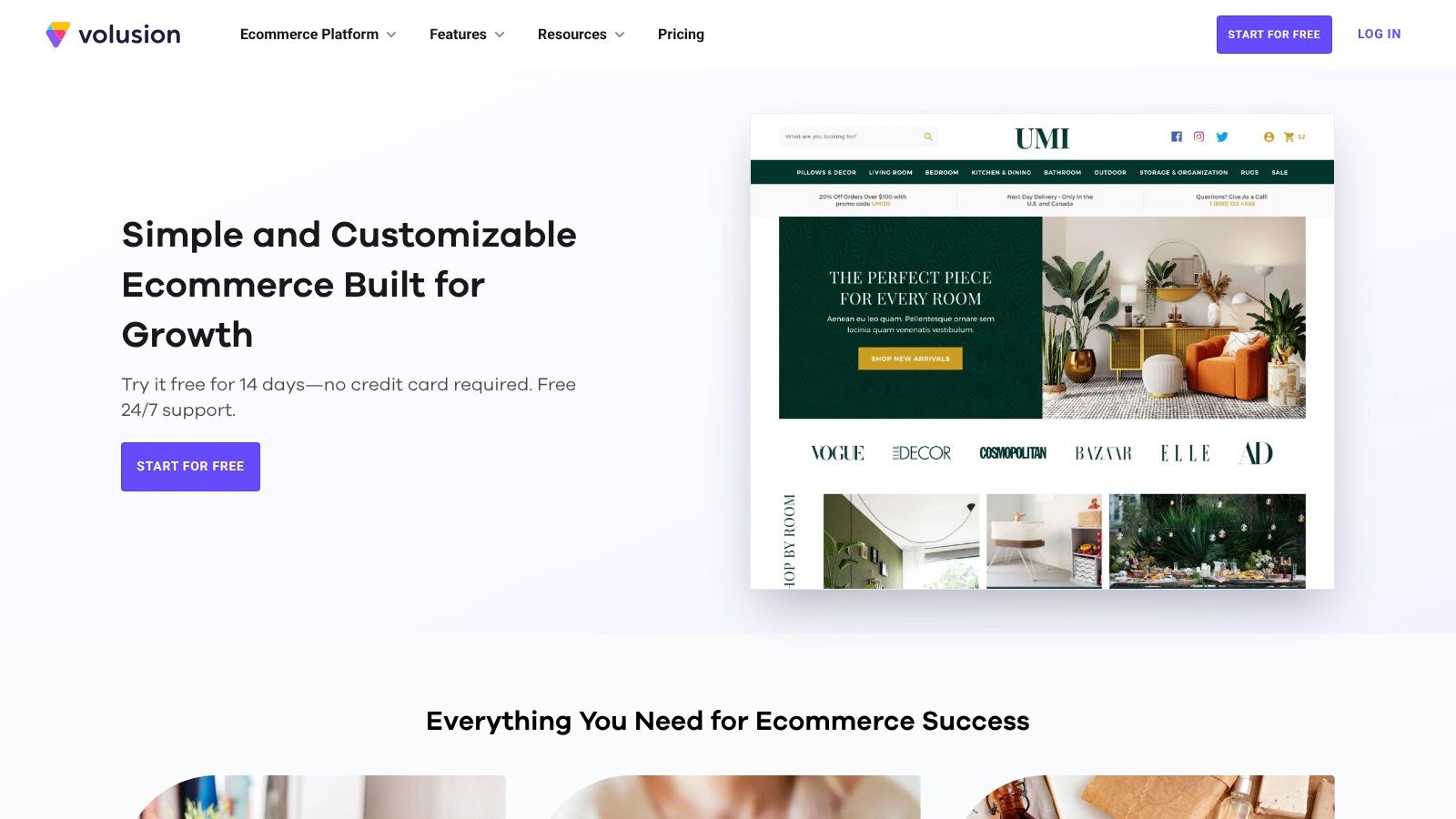
For businesses in the EE region looking to establish a strong online presence, Volusion presents a compelling option. Its integrated inventory management system allows for efficient tracking of stock levels, simplifying logistics and ensuring timely order fulfillment. The built-in marketing tools offer a range of capabilities, from email marketing to SEO features, enabling businesses to reach a wider audience and drive sales within the EE market. The platform also provides responsive mobile themes, crucial for capturing the growing number of mobile shoppers in the region.
Compared to platforms like Shopify or BigCommerce, Volusion prioritizes a more self-contained ecosystem. While this results in fewer apps and integrations compared to its larger competitors, it also means less reliance on third-party tools, potentially simplifying management and reducing costs. This streamlined approach can be particularly beneficial for smaller businesses in the EE region who may not have the resources to manage a complex web of interconnected apps. For instance, a small Estonian crafts business selling handmade goods can leverage Volusion's built-in inventory management to track stock levels, integrated marketing tools to promote new product lines on social media, and responsive themes to ensure their website looks great on any device, all without needing external plugins.
Setting up a Volusion store is designed to be straightforward. The user-friendly interface allows for intuitive navigation and customization. Choose from a selection of pre-designed themes and tailor them to your brand’s aesthetics. Upload product information, configure shipping options, and connect payment gateways, all within the Volusion platform. While specific technical requirements are minimal, a stable internet connection and basic computer literacy are sufficient to get started.
Volusion offers several pricing plans catering to businesses of different sizes. While specific pricing details can be found on their website (https://www.volusion.com), plans generally vary based on features, bandwidth, and the number of products you can sell. A key advantage is the absence of transaction fees on any of their plans, unlike some competitors. This can translate into significant savings for businesses processing a high volume of sales, making Volusion a cost-effective solution for ecommerce in the EE region.
While Volusion offers a compelling package, it's essential to be aware of its limitations. Design flexibility can be somewhat restricted compared to platforms offering more extensive theme customization options. The smaller app ecosystem might limit integration with specialized services you may require down the line. Bandwidth limitations on lower plans could be a concern for businesses anticipating high traffic volumes. Finally, Volusion's smaller market share compared to giants like Shopify means finding readily available expert support or community-based solutions might occasionally be more challenging.
Despite these limitations, Volusion's comprehensive built-in features, lack of transaction fees, good customer support, and user-friendly interface make it a worthy contender for best ecommerce website design, especially for small and medium-sized businesses in the EE region seeking a streamlined and all-inclusive platform to build and manage their online stores. It offers a balanced approach, providing the essential tools to succeed in the competitive ecommerce landscape without overwhelming users with unnecessary complexity.
9. Shift4Shop (formerly 3dcart)
Shift4Shop (formerly 3dcart) carves a unique niche in the crowded ecommerce platform landscape by offering a powerful and feature-rich solution with a surprisingly attractive free plan. This makes it a compelling choice for businesses in the EE region looking to establish or enhance their online presence, particularly those focused on achieving the best ecommerce website design without breaking the bank. It offers a comprehensive suite of tools that covers everything from website building and design to marketing, SEO, and multi-channel selling, allowing businesses to manage their entire online operation from a single platform.
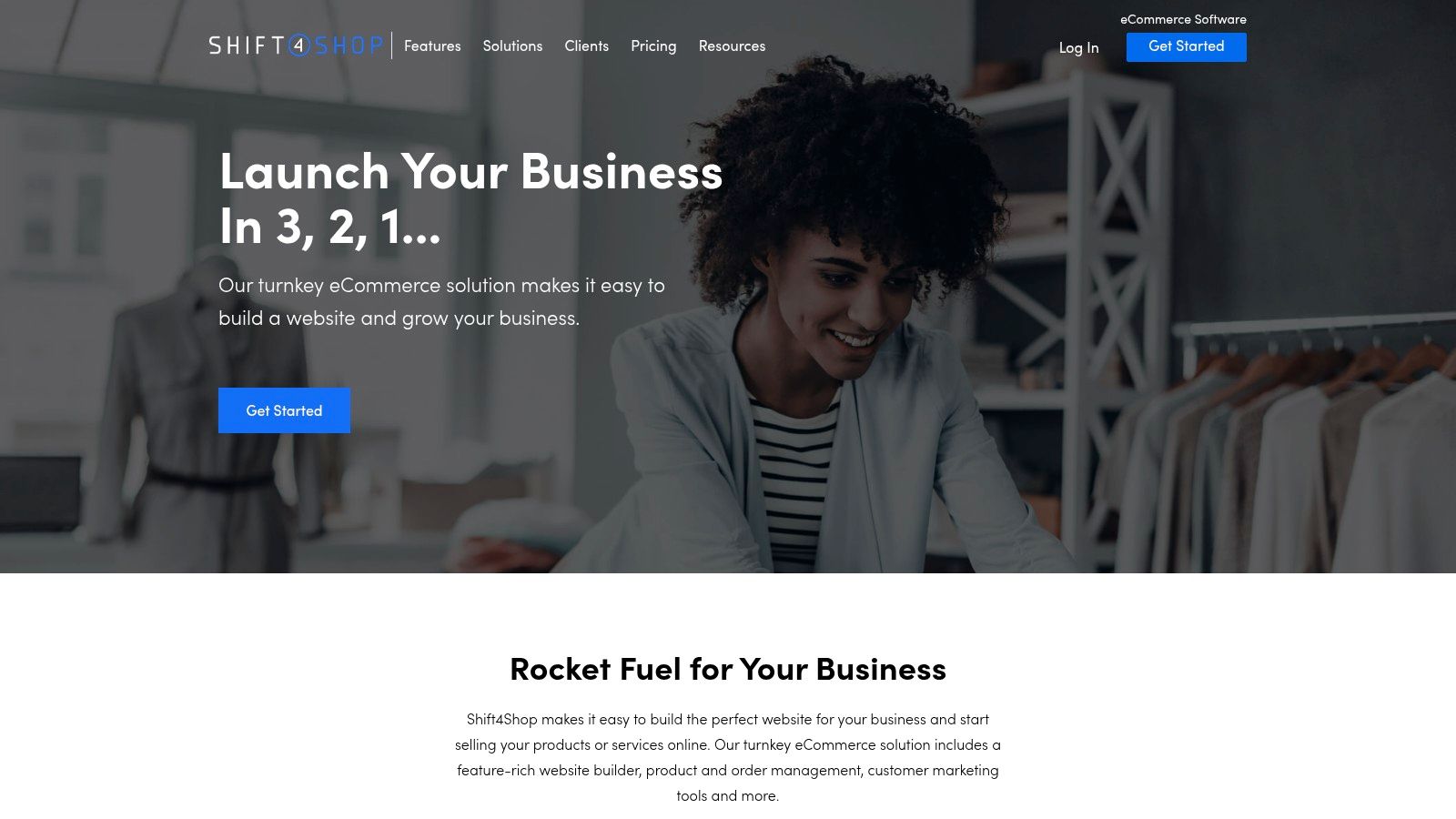
One of Shift4Shop’s most distinctive features is its free plan. While most ecommerce platforms charge monthly or annual fees, Shift4Shop offers a completely free option for businesses that use their in-house payment processing service, Shift4 Payments. This can represent significant cost savings, especially for startups and small businesses. However, it's important to note that this free plan locks you into their payment processor, which might not be the most ideal solution for every business. You’ll need to carefully weigh the benefits of the free platform against the potential limitations of the payment gateway. Consider transaction fees, supported currencies, and available features within the EE region before committing.
Beyond the free plan, Shift4Shop provides a robust set of features designed to empower businesses to build and manage a successful online store. These features include unlimited products and bandwidth, allowing for scalability as your business grows. The built-in blog and CMS functionality allows for content marketing and effective SEO strategies, crucial for driving organic traffic to your website. Learn more about Shift4Shop (formerly 3dcart) and how features like these contribute to a successful website. Moreover, the platform offers advanced SEO tools, helping businesses optimize their product listings and content for search engines, improving their visibility and ranking for keywords like "best ecommerce website design." Multi-channel selling capabilities enable businesses to expand their reach beyond their website and sell on platforms like Amazon and eBay, further maximizing their sales potential.
For businesses in the EE region aiming for international expansion, Shift4Shop's support for multiple currencies and languages is a key advantage. This facilitates reaching a wider audience and catering to diverse customer bases. The platform’s comprehensive marketing suite, including email marketing, promotions, and customer loyalty programs, allows for targeted campaigns and effective customer engagement.
While Shift4Shop offers a powerful set of features, there are some drawbacks to consider. The interface, while functional, can feel somewhat dated compared to more modern platforms like Shopify or BigCommerce. This can make the initial learning curve a bit steeper, especially for users unfamiliar with ecommerce platforms. Additionally, Shift4Shop’s community is smaller compared to the larger platforms, which means finding resources and support might be slightly more challenging. While the advanced features offer significant control and customization options, mastering them requires time and effort.
For startups and tech firms, Shift4Shop’s flexibility and comprehensive feature set offer a solid foundation for building a scalable online store. For small and medium-sized enterprises, the platform's robust features, coupled with the potential for cost savings through the free plan, make it an attractive option. Online retailers seeking a scalable ecommerce solution will appreciate the unlimited products and bandwidth, multi-channel selling capabilities, and advanced marketing tools. Brands and organizations focused on UI/UX design might find the dated interface a drawback, however, the platform's inherent SEO capabilities and marketing features are still valuable assets. Entrepreneurs and freelancers can leverage Shift4Shop to create professional business-card sites or landing pages to showcase their services and generate leads.
In summary, Shift4Shop offers a compelling value proposition for businesses seeking a comprehensive ecommerce solution. Its free plan, robust features, and focus on SEO make it a strong contender in the quest for the best ecommerce website design. While the dated interface and smaller community might be drawbacks for some, the platform’s strengths in functionality and affordability make it a worthwhile consideration, particularly for businesses in the EE region seeking a powerful and cost-effective platform. Be sure to weigh the pros and cons, considering your specific needs and technical expertise before making a decision. You can visit their website here.
10. Weebly eCommerce
Weebly eCommerce, now integrated with Square, presents a compelling solution for businesses in the EE region looking to establish or enhance their online presence. This platform shines with its drag-and-drop interface, making it exceptionally user-friendly, even for those without prior web design experience. This ease of use combined with Square's robust payment processing capabilities positions Weebly eCommerce as an excellent choice for small businesses and entrepreneurs seeking a straightforward yet effective platform for building their online stores. Whether you’re selling handcrafted goods, digital products, or professional services, Weebly offers the tools necessary to showcase your offerings and manage your transactions efficiently. Its seamless integration with Square’s ecosystem also streamlines operations by unifying online and offline payments, simplifying inventory management, and providing valuable sales data. This makes it especially attractive for businesses operating both online and in physical retail locations within the EE region.
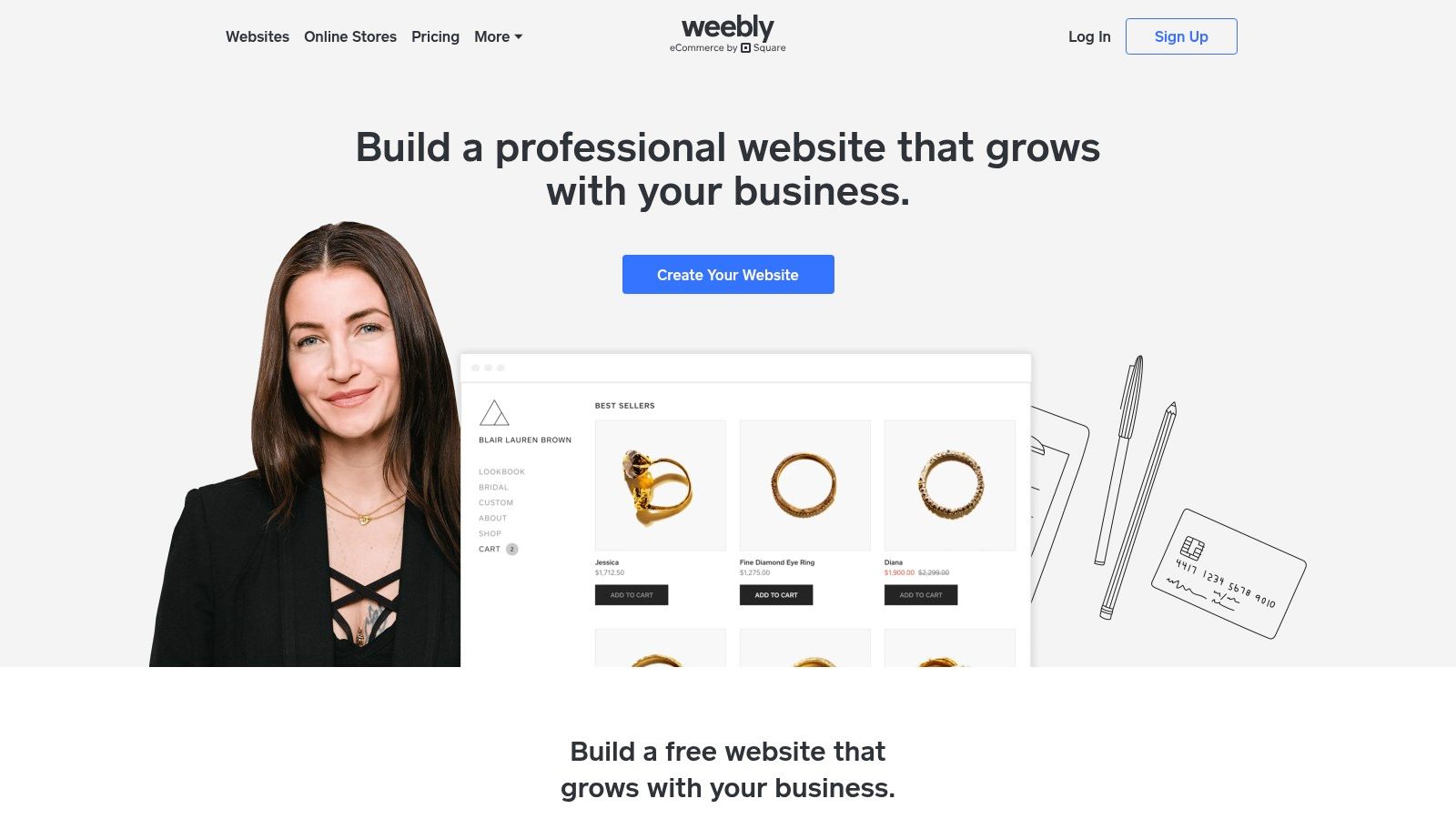
Weebly's key strength lies in its simplicity. The drag-and-drop website builder eliminates the need for coding knowledge, allowing users to intuitively design and customize their online storefronts. Choose from a selection of mobile-responsive themes, ensuring your website looks professional and functions flawlessly across all devices. This is crucial in today's mobile-first world, where a significant portion of online shopping happens on smartphones and tablets. Weebly’s built-in SEO tools further empower businesses in the EE region to improve their search engine visibility and attract more organic traffic. Features like customizable meta descriptions, title tags, and alt text help ensure your website ranks well for relevant keywords, connecting you with potential customers actively searching for the products or services you offer. The integrated inventory management system also simplifies stock control, reducing the risk of overselling and ensuring efficient order fulfillment.
For businesses already leveraging Square's POS system, the integration with Weebly eCommerce provides a significant advantage. This seamless connection allows for streamlined payment processing, synchronized inventory across online and physical stores, and a unified view of sales data. This is particularly beneficial for businesses operating in multiple channels, providing greater control and efficiency in managing sales and inventory. This integration simplifies accounting and reporting, saving valuable time and resources.
While Weebly eCommerce offers a robust solution for small to medium-sized businesses, it is important to acknowledge its limitations. Compared to more advanced platforms like Shopify or BigCommerce, Weebly offers fewer advanced ecommerce features and a more basic app marketplace. This can limit scalability for larger businesses with complex needs or rapid growth trajectories. The design options, while aesthetically pleasing and functional, are less extensive than those offered by some competitors. This might be a consideration for brands prioritizing highly customized designs or requiring unique functionalities. However, for businesses prioritizing ease of use and tight integration with Square, Weebly offers a compelling value proposition.
Pricing varies depending on the chosen plan. Weebly offers free and paid plans, with the latter providing additional features like a custom domain, increased storage, and advanced ecommerce functionalities. Specific pricing details are available on the Weebly website.
Technical requirements are minimal, as Weebly is a cloud-based platform. All you need is a computer with internet access to build and manage your online store.
Implementation tips:
- Start with a clear plan: Outline your business goals, target audience, and product offerings before designing your website. This ensures a focused and effective online presence.
- Choose a suitable theme: Select a theme that aligns with your brand identity and caters to your target audience's preferences.
- Optimize product descriptions: Use high-quality images and compelling product descriptions to showcase your offerings.
- Leverage SEO tools: Utilize Weebly’s built-in SEO tools to optimize your website for search engines and improve visibility.
- Integrate with Square: Connect your Weebly store with Square for seamless payment processing and inventory management.
In conclusion, Weebly eCommerce offers a compelling platform for businesses in the EE region seeking an easy-to-use, affordable, and effectively integrated ecommerce solution. Its seamless connection with Square's payment processing and POS systems makes it especially attractive for businesses looking to streamline operations and expand their online presence. While it may not be suitable for large businesses with complex needs, Weebly’s simplicity and user-friendliness make it an excellent option for small to medium-sized enterprises, startups, and entrepreneurs entering the ecommerce landscape. For more details and to explore the platform, visit https://www.weebly.com.
Top 10 Ecommerce Design Platforms Comparison
| Platform | Core Features ✨ | User Experience ★★★★☆ | Value Proposition 💰 | Target Audience 👥 | Unique Selling Points 🏆 |
|---|---|---|---|---|---|
| Shopify | Drag-and-drop builder, multi-channel selling | Beginner-friendly, 24/7 support | From $29/mo 💰, extensive app ecosystem | SMBs, startups, enterprises | Large app marketplace, reliable hosting |
| WooCommerce | Full WordPress integration, SEO-friendly | Flexible but technical | Free core, no transaction fees 💰 | WordPress users, dev-savvy | Open-source, unlimited customization |
| BigCommerce | No transaction fees, SEO & B2B tools | Scalable, advanced but complex | From $29/mo 💰, no transaction fees | Growing businesses, B2B | Enterprise features, strong API |
| Squarespace | Designer templates, blogging, SEO tools | Beautiful designs, mobile-optimized | From $16/mo 💰, all-in-one platform | Creatives, lifestyle brands | Award-winning templates, content marketing focus |
| Wix eCommerce | Drag-and-drop, ADI, 500+ templates | Very user-friendly, quick setup | Affordable plans 💰, free plan available | Small to mid-sized businesses | Artificial Design Intelligence |
| Magento Commerce | Advanced B2B/B2C, multi-store management | Highly flexible, steep learning curve | Higher cost 💰, enterprise-level | Large enterprises | Extensive customization, multi-store support |
| PrestaShop | Multi-language, SEO tools, analytics | Good flexibility, technical setup needed | Free core 💰, paid modules for extras | International, tech-savvy | Strong multi-currency support |
| Volusion | Inventory, marketing, abandoned cart recovery | User-friendly, fewer apps | Competitive pricing, no transaction fees | SMBs | Comprehensive built-in features |
| Shift4Shop | Unlimited products, multi-channel, SEO | Good feature set, learning curve | Free plan with Shift4 Payments 💰 | SMBs preferring all-in-one | Free plan with payment processor |
| Weebly eCommerce | Drag-and-drop, Square POS integration | Very easy for beginners | Affordable plans 💰 | Small businesses, entrepreneurs | Seamless Square payment/POS integration |
Crafting Your Perfect Online Store
From the simplicity of Squarespace and Wix to the robust scalability of Shopify and Magento, the tools we've explored offer a diverse range of options for achieving the best ecommerce website design. The key takeaway is that there's no one-size-fits-all solution. Choosing the right platform hinges on carefully considering your specific business needs, budget, technical expertise, and future growth projections. Remember to weigh the pros and cons of each platform based on factors like transaction fees, customization options, SEO capabilities, and built-in marketing tools.
As you move forward, ensuring your online store follows best practices for performance and user experience is crucial. For a deeper dive into optimizing your online store's performance, check out this comprehensive guide on ecommerce website best practices from Wand Websites. This resource will equip you with valuable insights for maximizing your online success. Selecting the right tools is just the beginning; implementing them effectively is what transforms a good online store into a great one.
Building a successful ecommerce presence requires a strategic blend of beautiful design, robust functionality, and seamless user experience. Ready to craft an online store that not only looks stunning but also drives conversions and elevates your brand in the EE region? Major Source specializes in helping businesses like yours create exceptional ecommerce experiences. We can guide you through the platform selection process, design a custom solution tailored to your needs, and ensure your online store is poised for success.




